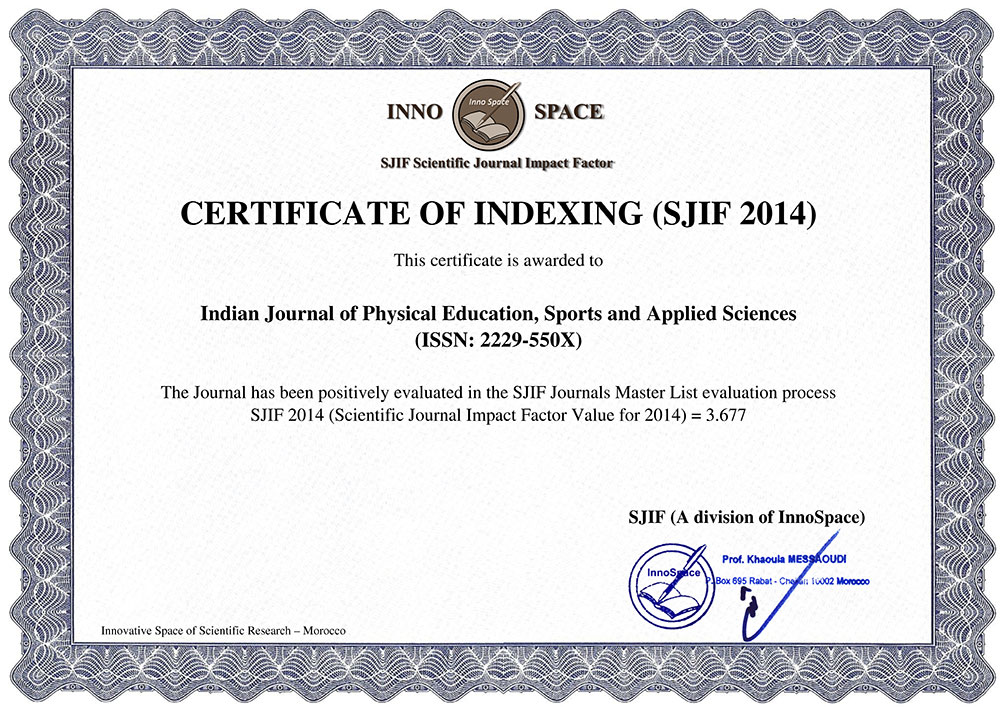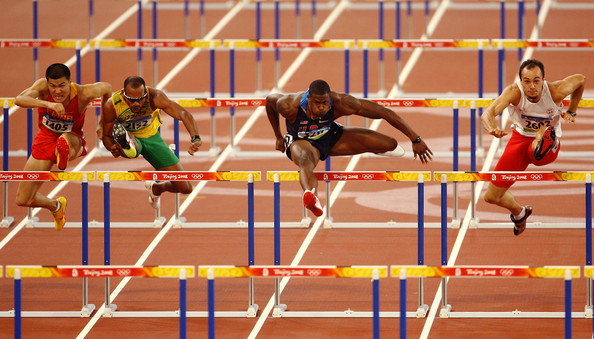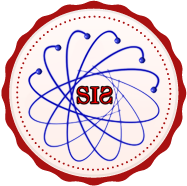Guidelines For Author
Publishing your research article in a IJPESAS journal is simple and efficient. Author can submit an article or research paper online from website of IJPESAS.: www.sportscientistsviews.com. Or by email- sharmagym59@yahoo.co.in
Manuscript Preparation
Manuscript length should be 6 to 18 pages. Science Publishing Group can exceptionally accept shorter or longer manuscripts, provided that the scientific content is of high value. No additional page charges are required if a manuscript is substantially longer than 17 pages. All submitted manuscripts must include the following items:
Manuscript Template
Please click here to download the template to format your manuscript
Title
List of authors, their affiliations and email addresses
Abstract
Introduction
Methodology
Results and discussion
Conclusions
Acknowledgments (optional)
References
Manuscript Checklist
Title
Make sure that the title is specific and concise. Titles should be presented in title case – all words except the first word should be in lower case letters.
List of authors, their affiliations and email addresses
Provide the full names and affiliations of all the authors. Affiliations should include department, university or organization, city, and country. One of the authors should be designated as the corresponding author, and their email address needs to
be included.
Abstract
The abstract should briefly introduce the manuscript, not exceeding 400 words. No citations should be included in the abstract.
Keywords
At least 3 to 5 keywords or phrases should be included and must be separated by commas to distinguish them.
Introduction
The introduction section should provide a context for your manuscript. When preparing the introduction, please bear in mind that some readers will not be experts in your field of research.
Main Body
The main body part should include the methodology (Selection of Subjects/Sample, Selection of Variables, Selection of instrument, Administration of Instrument and Statistical Techniques) main proposed ideas, results and
discussions.
Conclusions
A conclusion is where you summarize the paper’s findings and generalize their importance, discuss ambiguous data, and recommend further research. An effective conclusion should provide closure for a paper, leaving the reader feeling satisfied that the concepts have been fully explained.
Acknowledgments
You as the author are free to decide whether to include acknowledgments or not. Usually, the acknowledgments section includes the names of people who in some way contributed to the work, but do not fit the criteria to be listed as the authors. This section of your manuscript can also include information about funding sources.
References
IJPESAS uses the numbered citation method for reference formatting, with sequential numbering in the text, and respective ordering in a list at the end of the paper.
REFERENCES AT THE END OF YOUR PAPER
JOURNAL
Single Author with DOI
Cooper, M.(2009). Human finger-prints: A knowledge evolution. Journal of Global Warming, 18(4) , 11 -35. doi:10.1073/pnas.0706147104
Two Author with DOI
Cooper, M. and Engelbart, D. (2009). Human finger-prints: A knowledge evolution. Journal of Global Warming, 18(4), 11 -35. doi:10.1073/pnas.0706147104
Three Author with DOI
Engelbart, D., Furuta, R., and Van de Walle, B. (2009). Human finger-prints: A knowledge evolution. Journal of Global Warming, 18(4), 11 -35. doi:10.1073/pnas.0706147104
Tannenbaum, R. V., Leung, K., & White, M. A. (2005). A re-examination of the notion of global warming. Journal of the Environment, 20, 168-196
More than Three Author with DOI
Cooper, M., Engelbart, D., Furuta, R., Hiltz, S. R., Noll, J., Preece, J., and Van de Walle, B. (2009). Human finger-prints: A knowledge evolution. Journal of Global Warming,
18(4), 11 -35. doi:10.1073/pnas.0706147104
BOOK
Electronic with DOI
Avgerou, C. (2003). Information systems and global diversity.
doi:10.1093/acprof:oso/9780199263424.001.0001
Electronic without DOI
Glosser, S. L. (2003). Chinese visions of family and state, 1915-1953. Retrieved from http://hdl.handle.net/2027/heb.04248.0001.001
Print
Gardner, H. (1993). Frames of mind: The theory of multiple intelligences. New York: Basic Books, 1993.
Print, with an editor
Updike, J. (Ed.). (1999). The best American short stories of the century. Boston: Houghton,Mifflin.
Print, when citing a chapter
Rubenstein, J. P. (1967). The effect of television violence on small children. In B. F. Kane (Ed.), Television and juvenile psychological development (pp. 112-134). New York: American Psychological Society.
Print, a translation
Freud, S. (1970.) An outline of psycho-analysis (J. Strachey, Trans.). New York:
Norton. (Original work published 1940).
No publication date
Smith, J. (n.d.). Morality in masquerade. London: Churchill.
Gardener, S. (2004). Anthropogenic global warming: How the world is changing.
New York: Morrow.
NEWS PAPER AND MAGAZINE
Electronic from a database
Altman, L. K. (2001, January 18). Mysterious illnesses often turn out to be mass hysteria. New York Times. Retrieved from the Factiva database.
Electronic from the website
Cary, B. (2001, June 18). Mentors of the mind. Los Angeles Times. Retrieved from http://www.latimes.com
Print
Monson, M. (1993, September 16). Urbana firm obstacle to office project. The ChampaignUrbana News-Gazette, pp. 1, 8.
Review
Gleick, E. (2000, December 14). The burdens of genius [Review of the book The last samurai, by H. DeWitt]. Time, 156, 171.
Editorial
Sovereignty in the human presence. [Editorial]. (2010, February, 21). The Globe and Mail, p. A9.
Article with no author
Bahrain streets calm but tense. (201 1, February 21) The Chronicle Herald. Retrieved from http://thechronicleherald.ca/World/1229146.html
INTERNET MATERIAL
Personal homepage
Duncan, D. (1998, August 1). Homepage. Retrieved July 30, 2007 from http://www.geocities .com/SoHo/Coffeehouse/1 652/
Posting to an online discussion group or listserv
Marcy, B. (1999, April 3). Think they’ll find any evidence of Mallory & Irvine [electronic mailing list message]. Retrieved from http://everest.mountainzone.com/99/forum
Social media, including blog posts, etc.
MiddleKid. (2007, January 22). The unfortunate prerequisites and consequences of partitioning your mind [Web log message]. Retrieved from http://scienceblogs.com/pharyngula/2007/01/the_unfortunate_prerequisites.php
Website of an organization or government
Wisconsin Department of Natural Resources. (2001). Glacial habitat restoration areas.Retrieved from http://www.dnr.state.wi.us/org/land/wildlife/hunt/hra.htm
Midwest League. (n.d.). Pitching, individual records. Retrieved from http://www.midwestleague.com/indivpitching.html
An online video
Norton, R. (2006, November 4). How to train a cat to operate a light switch [Video file].Retrieved from http://www.youtube.com/watch?v=Vja83KLQXZs
A PowerPoint presentation
Geist, M. (2010). The truth about ACTA [Presentation slides]. Retrieved from http://www slideshare.net/mgeist/the-truth-about-acta
REPORT
Industry report from a database
Datamonitor. (2010, March 12). Global Banks: Industry profile. Retrieved from Datamonitor 360 database.
Company report from a database
Global Data (2010, October 25). Nortel Networks Corporation (NRTLQ) – Financial and Strategic Analysis Review. Retrieved from Investext database.
From a company Website
Microsoft Corp. (2006). Annual report. Retrieved from http://www.microsoft.com/msft/reports /ar06/
DISSERTATION AND THESIS
Electronic from a database
Mancall, J. C. (1979). Resources used by high school students in preparing independent study projects: A bibliometric approach (Doctoral dissertation). Retrieved from ProQuest Dissertations and Theses database. (UMI No. AAT 7905069)
Print obtained from a university
Carlson, W. R. (1977). Dialectic and rhetoric in Pierre Bayle. (Unpublished doctoral dissertation). Yale University, USA.
Print abstract from DAI
Delgado, V. (1997). An interview study of Native American philosophical foundations in education. Dissertation Abstracts International: Section A. Humanities and Social Sciences, 58(9), 3395.
ENCYCLOPEDIAS AND REFERENCE MATERIALS
Electronic with DOI
Levi, D. M. (2010.) Amblyopia. In Dartt, D. A., et al. (Eds.), Encyclopedia of the eye (2010 ed., pp. 63-66). doi:10.1016/B978-0-12-374203-2.00243-8
Electronic without DOI
Tolan, J. (2011.) Petrus Alfonsi. In P. Bearman, et al. (Eds.), Encyclopaedia of Islam (2nd ed.). Retrieved from http://www.brillonline.nl /subscriber/ entry? entry= slam SIM-6120
Print, signed entry
MacKintosh, Nicholas John. (2010). Animal learning. In D.H. Hoiberg (Ed.), Encyclopaedia Britannica (15th ed., Vol. 22, pp. 854-869). Chicago: Encyclopaedia Britannica, Inc.
Print, unsigned entry
Acer saccharum. (2004). In G. Sternberg (Ed.), Native trees for North Amer
CONFERENCE PROCEEDINGS
Electronic with DOI
Heerikhuisen, J., Pogorelov, N., & Zank, G. (2010). IBEX ribbon from outer heliosheath pickup Ions. AIP Conference Proceedings, USA, 1302(1), 98-103. doi:10.1063/1.3529997
Electronic without DOI
Miller, S. (2000). Introduction to manufacturing simulation. Proceedings of the 2000 Winter Simulation Conference, USA, 33, 63-66. Retrieved from http://www. informssim. org/wsc00papers/011.PDF
Print
Etoroma, E.E. (1997). Black community building in Hamilton: Problems and aspects. In J.Cohnstaedt & Y. Frenette (Eds.), Canadian cultures and globalization: Selected proceedings of the 23rd annual conference of the Association for Canadian Studies. Montreal: Association for Canadian Studies.
PATENTS
Electronic
Lemelson, J.H. (1981). U.S. Patent No. 4,285,338. Retrieved from http:// http://patft.uspto.gov/
Print
Lemelson, J.H. (1981). U.S. Patent No. 4,285,338. Washington, DC: U.S. Patent and Trademark
The list should contain at least ten references and should be arranged in the order of citation in text. List only one reference per reference author. Citations of references may be given simply as “in ( Author last name, Year). Multiple citations within a single set of brackets should be separated by commas.
Word Processing Formats
Before submission, please ensure that your articles are in the form of Microsoft word 2003 (doc) or Microsoft word 2007/2010(docx). These two forms of the articles are acceptable for journal in order to typeset the articles into IJPESAS format.
Publication Presentation
After publishing in IJPESAS your article will be presented in the form of PDF.
You can pay attention to IJPESAS website to check the Online Version of your article.
INSTRUCTIONS FOR REVIEWERS
Qualification & Requirement for a Potential Reviewer
1. The applicant is requested to possess at least 2-year research or working experience in the related areas of the applied journal.
2. The applicant with doctor degree or above will be given priority.
3. The applicant should have no less than 2 publications in the same topic area of the applied journal.
4. The applicant with relevant working experience is preferred.
Benefits for Reviewers
Being on a reviewer of a journal is truly productive, pleasant and in fact prestigious which helps in add-on to the scientific world through the ways and guidelines given by experts in the relevant fields. Though, it is time consuming and often goes unobserved, there are some important rewards that make the reviewers worthwhile. You will be entitled following benefits while working with us as a reviewer of the journal.
1. You are enforced to read carefully various manuscripts in your area of importance and interest. This is the way you are routinely forced to keep yourself up-to-date while checking and suggesting the changes in manuscript.
2. This work helps to add in and provides a better way to create your identity as a well known expert in your field and may lead to increased invitations to speak at conferences or demand for invited research of your specialized area.
3. You will be among the contributors who will shape and decide the urgent ways as required with changing societal needs.
4. You will come across the latest research before everyone else and gives you a position of leadership in your research community.
5. The reviewers who need financial support could enjoy 10% discount to publish their articles in IJPESAS.
Responsibilities of Reviewers
We need our reviewers to be key figures in their professions to have some experience of publishing articles. A reviewer’s comment decides the acceptance or rejection of an article so they play an important role in peer review process. All the members are requested to test out the articles submitted to them without any bias to increase the quality of our journals. There is no hard and fast rule to analyse an article and it depends upon the worthiness, quality and originality. While verifying the article, you have to go through following points:
1. Detailed examination and relevance of the article as per author guidelines.
2. Careful examination of purposes and objectives of the work carried out.
3. Correctness of the conclusions and recommendations along with up-to-date references.
4. Copyediting and proofreading of the manuscripts in accordance with publishing standards especially with grammar, punctuation and spelling.
5. Coverage areas of the manuscript in relevance with the scopes of journals.
6. Plagiarism related issues if any.
7. You have to give some suggestions based on the structure of the manuscript. In general, there is no limit for the maximum inputs.







